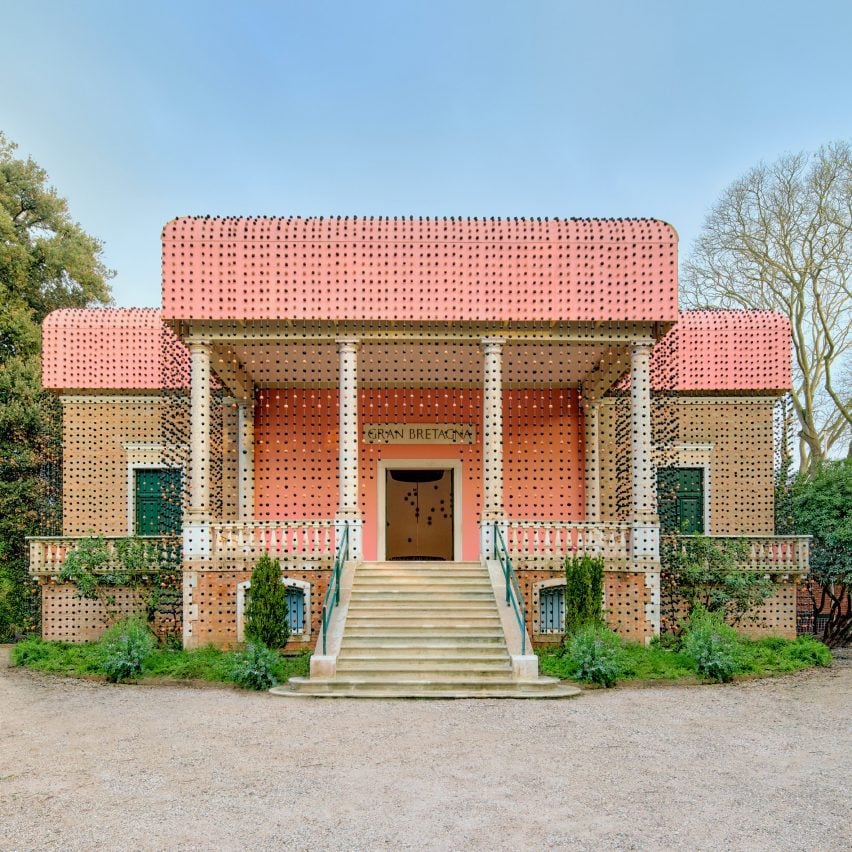Curators from the UK and Kenya have overhauled the British Pavilion at the Venice Architecture Biennale, which is revealed as part of our day of exclusive online openings, with installations that aim to reconnect architecture with the earth.
Titled GBR – Geology of Britannic Repair, the pavilion aims to explore themes related to colonialism, the built environment and geological extraction.

Commissioned by the British Council, the pavilion was curated by British writer Owen Hopkins, Queen Mary University professor Kathryn Yusoff, and Cave Bureau co-founders Karanja and Stella Mutegi.
As part of the installation, the exterior of the pavilion was covered in a beaded veil made from spheres of agricultural waste briquettes and clay with red glass beads.

Named Double Vision, the veil was made from agricultural waste and clay from India and Kenya, respectively. It was designed to recall earthen materials that may have been displaced because of colonialism.
“The contention at the heart of the exhibition is that architecture is an earth practice,” Hopkins told Dezeen.
“The exhibition aims to unlock what architecture and colonialism have long marginalised, activating the British Pavilion as a site for reimagining the relationship between architecture and the earth.”

Inside the pavilion are six further installations. Earth Compass features maps of the night sky above London and Nairobi from the day Kenya gained independence from British control, while Rift Room contains a bronze cast of a Kenyan Rift Valley cave known locally as the “baboon parliament”.
Elsewhere in the pavilion, architecture group Palestine Regeneration Team created the Objects of Repair installation, which explores the potential of using salvage materials to rebuild war-torn Gaza.

Cave Bureau worked with researcher Phil Ayres to create an organically shaped, woven rattan structure, designed as a real-life scale reproduction of a section of the Shimoni Slave Caves in Kenya.
Architect Thandi Loewenson presented a series of graphite drawings in Lumumba’s Grave, while Ghanaian-Filipino designer Mae-ling Lokko and Argentine architect Gustavo Crembil looked at transforming Kew Gardens’ Palm House in their design, Vena Cava.
Hopkins explained that the curators wanted this year’s British Pavilion to engage with the history of its building and the Giardini site.
“When we did our first recce to Venice, we thought a lot about what it means for a UK-Kenya team to be doing an exhibition in the British Pavilion,” he said.

“The Giardini is essentially a 19th-century kind of space, representing a view of the world where imperial ‘great powers’ are competing for cultural preeminence,” Hopkins continued.
“Any project in that context unavoidably enters into dialogue with that past and present, and we became interested in how we might actively engage with it.”

The pavilion’s seven installations were designed to be related to the Great Rift Valley – a geological formation that travels from southern Turkey and through the Red Sea to Ethiopia, Kenya and Mozambique.
“We realised there was this interesting alignment where the front of the pavilion points north-west towards the UK, while the back looks south-east towards Kenya,” said Hopkins.

“We began to see the pavilion as a nodal point on an axis part of which runs along the Great Rift Valley, so the rift became the exhibition’s geographical, geological and conceptual focus,” he continued.
“It’s where many of the projects on show in the exhibition emanate from, but also operates as a method from which to theorise and enact practices of resistance to the geological worlds of colonialism and the inequality, injustice and environmental degradation they have brought about.”
This year’s Venice Architecture Biennale has been curated by Italian architect Carlo Ratti. In an exclusive interview with Dezeen, he said the core focus of the event is the climate crisis and people.
Other pavilions at the Venice Architecture Biennale exclusively revealed on Dezeen today include the Danish Pavilion, which has been turned into a construction site by Søren Pihlmann and the Finland Pavilion, which tells the “untold story” of Alvar Aalto-designed building.
The photography is by Chris Lane.
The Venice Architecture Biennale takes place from 10 May and 23 November 2025. See Dezeen Events Guide for all the latest information you need to know to attend the event, as well as a list of other architecture and design events taking place around the world.
The post British Pavilion cloaked in veil of clay beads at Venice Architecture Biennale appeared first on Dezeen.

